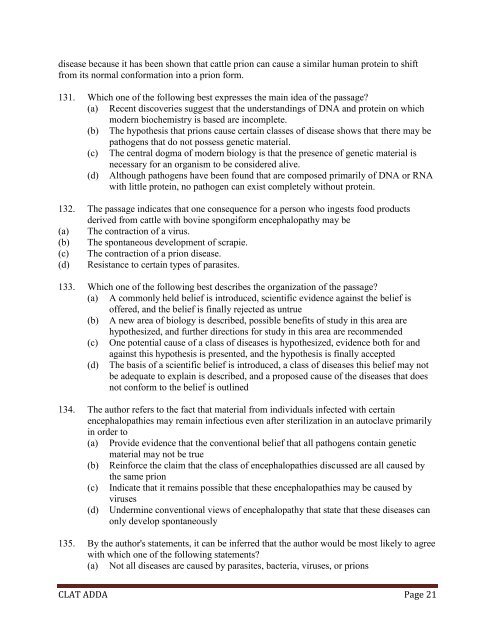NALSAR University of Law, Hyderabad ENTRANCE TEST PAPER ...
NALSAR University of Law, Hyderabad ENTRANCE TEST PAPER ...
NALSAR University of Law, Hyderabad ENTRANCE TEST PAPER ...
You also want an ePaper? Increase the reach of your titles
YUMPU automatically turns print PDFs into web optimized ePapers that Google loves.
disease because it has been shown that cattle prion can cause a similar human protein to shift<br />
from its normal conformation into a prion form.<br />
131. Which one <strong>of</strong> the following best expresses the main idea <strong>of</strong> the passage?<br />
(a) Recent discoveries suggest that the understandings <strong>of</strong> DNA and protein on which<br />
modern biochemistry is based are incomplete.<br />
(b) The hypothesis that prions cause certain classes <strong>of</strong> disease shows that there may be<br />
pathogens that do not possess genetic material.<br />
(c) The central dogma <strong>of</strong> modern biology is that the presence <strong>of</strong> genetic material is<br />
necessary for an organism to be considered alive.<br />
(d) Although pathogens have been found that are composed primarily <strong>of</strong> DNA or RNA<br />
with little protein, no pathogen can exist completely without protein.<br />
132. The passage indicates that one consequence for a person who ingests food products<br />
derived from cattle with bovine spongiform encephalopathy may be<br />
(a) The contraction <strong>of</strong> a virus.<br />
(b) The spontaneous development <strong>of</strong> scrapie.<br />
(c) The contraction <strong>of</strong> a prion disease.<br />
(d) Resistance to certain types <strong>of</strong> parasites.<br />
133. Which one <strong>of</strong> the following best describes the organization <strong>of</strong> the passage?<br />
(a) A commonly held belief is introduced, scientific evidence against the belief is<br />
<strong>of</strong>fered, and the belief is finally rejected as untrue<br />
(b) A new area <strong>of</strong> biology is described, possible benefits <strong>of</strong> study in this area are<br />
hypothesized, and further directions for study in this area are recommended<br />
(c) One potential cause <strong>of</strong> a class <strong>of</strong> diseases is hypothesized, evidence both for and<br />
against this hypothesis is presented, and the hypothesis is finally accepted<br />
(d) The basis <strong>of</strong> a scientific belief is introduced, a class <strong>of</strong> diseases this belief may not<br />
be adequate to explain is described, and a proposed cause <strong>of</strong> the diseases that does<br />
not conform to the belief is outlined<br />
134. The author refers to the fact that material from individuals infected with certain<br />
encephalopathies may remain infectious even after sterilization in an autoclave primarily<br />
in order to<br />
(a) Provide evidence that the conventional belief that all pathogens contain genetic<br />
material may not be true<br />
(b) Reinforce the claim that the class <strong>of</strong> encephalopathies discussed are all caused by<br />
the same prion<br />
(c) Indicate that it remains possible that these encephalopathies may be caused by<br />
viruses<br />
(d) Undermine conventional views <strong>of</strong> encephalopathy that state that these diseases can<br />
only develop spontaneously<br />
135. By the author's statements, it can be inferred that the author would be most likely to agree<br />
with which one <strong>of</strong> the following statements?<br />
(a) Not all diseases are caused by parasites, bacteria, viruses, or prions<br />
CLAT ADDA Page 21


